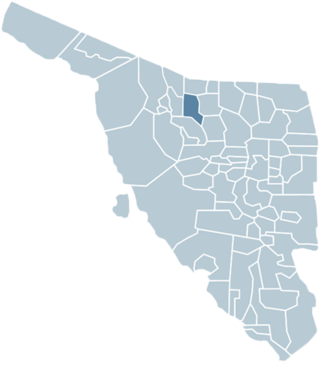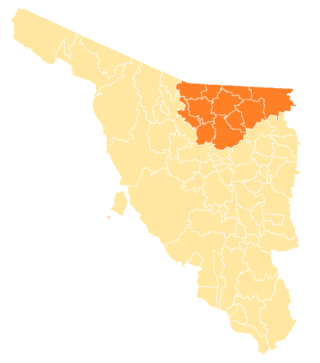
Sonora, officially Estado Libre y Soberano de Sonora, is one of the 31 states which, along with Mexico City, comprise the Federal Entities of Mexico. The state is divided into 72 municipalities; the capital city of which being Hermosillo, located in the center of the state. Other large cities include Ciudad Obregón, Nogales, San Luis Río Colorado, and Navojoa.
Agua Prieta is a town in Agua Prieta Municipality in the northeastern corner of the Mexican state of Sonora. It stands on the Mexico–U.S. border, adjacent to the town of Douglas, Arizona. The municipality covers an area of 3,631.65 km2. In the 2010 census the town had a population of 79,138 people, making it the seventh-largest community in the state, and a literacy rate of 96.3%.

Heroica Nogales, more commonly known as Nogales, is a city and the county seat of the Municipality of Nogales in the Mexican state of Sonora. It is located in the north of the state across the U.S.-Mexico border, and is abutted on its north by the city of Nogales, Arizona.

Santa Ana is a small city and municipal seat of Santa Ana Municipality in the Mexican state of Sonora. It is located 168 kilometres (104 mi) north of the state capital Hermosillo and 100 kilometres (62 mi) south of Nogales on the United States border. The town had a 2005 census population of 10,593 inhabitants.

Cananea is a municipality in the northern portion of the Mexican state of Sonora, on the U.S. border. Its municipal seat is the city of Cananea, located at 30°58′55″N110°18′02″W.

Magdalena de Kino is a city, part of the surrounding municipality of the same name, located in the Mexican state of Sonora covering approximately 560 square miles. According to the 2005 census, the city's population was 23,101, and the municipality's was 25,500. Magdalena de Kino is in the northern section of Sonora 50 miles from the Mexico-U.S. border. To the north the municipality abuts Nogales; to the south, the municipality of Santa Ana; to the east, Ímuris and Cucurpe; and to the west, the municipalities of Tubutama and Sáric. Its main sectors include San Ignacio, San Isidro, Tacicuri, and Sásabe. The city was named after the pioneer Roman Catholic missionary and explorer, Father Eusebio Francisco Kino, who worked in the area, as well as in the present-day US state of Arizona.
Imuris is the municipal seat of Imuris Municipality in the north of the Mexican state of Sonora.

Bacoachi is a small town in Bacoachi Municipality in the north of the Mexican state of Sonora. The area of the municipality is 487 square miles (1,260.65 km2) and the population was 1,456 in 2005, with 924 inhabitants residing in the municipal seat. The elevation of the municipal seat is 4,429 feet above sea level.

Baviácora is a small town and the municipal seat of the surrounding municipality of the Mexican state of Sonora. The geographical coordinates are 29°42′N110°09′W.

Arizpe (municipality) is a municipality in the Mexican state of Sonora in north-western Mexico. The Municipality of Arizpe is one of the 72 municipalities of the state of Sonora, located in the north-central region of the state in the Sierra Madre Occidental area. It has 72 localities within the municipality, its municipal seat and the most populated locality is the homonymous town of Arizpe, while other important ones are: Sinoquipe, Bacanuchi and Chinapa. It was named for the first time as a municipality in 1813 and according to the 14th Population and Housing Census carried out in 2020 by the National Institute of Statistics and Geography (INEGI) the municipality has a total population of 2,788 inhabitants. This municipality has an area of 1,186.56 square miles (3,073.17 km2). Its Gross Domestic Product per capita is USD 11,012, and its Human Development Index (HDI) is 0.8292.
Empalme (municipality) is a municipality in the Mexican state of Sonora in north-western Mexico. As of 2015, the municipality had a total population of 56,177. The municipal seat is the homonymous city.
Guaymas Municipality is a municipality in the Mexican state of Sonora in north-western Mexico. In 2015, the municipality had a total population of 158,046. The municipal seat is the city of Guaymas.
Huatabampo is a municipality in the state of Sonora in north-western Mexico. As of 2015, the municipality had a total population of 80,524.
Imuris Municipality is a municipality in the Mexican state of Sonora in north-western Mexico.

The Municipality of Magdalena de Kino is a municipality ('county') in the Mexican state of Sonora in Northwestern Mexico.

Naco Municipality is a municipality in the Mexican state of Sonora in northwestern Mexico.

Puerto Peñasco Municipality is a municipality in the Mexican state of Sonora in north-western Mexico. As of 2015, the municipality had a total population of 62,177 inhabitants. The only locality with a significant population is the municipal seat, also named Puerto Peñasco, which contains almost 99% of the municipality's population.
San Luis Río Colorado is a municipality in the Mexican state of Sonora in northwestern Mexico, covering an area of 8412.75 km2.

Armando López Nogales is a Mexican former lawyer and politician who was the Governor of Sonora from 1997 to 2003 as a member of the Institutional Revolutionary Party (PRI). He also served as a Senator in the LVI Legislature of the Mexican Congress representing Sonora, as well as a federal deputy in the LIV Legislature, representing Sonora's first district.

The second federal electoral district of Sonora is one of the 300 electoral districts into which Mexico is divided for elections to the federal Chamber of Deputies and one of seven such districts in the state of Sonora.
















